Ever thought about how your home could help the planet? As eco-friendly living gains traction, the role of sustainable home design becomes critical. By adopting green architecture, you can turn your home into an eco-friendly sanctuary. This approach not only cuts down your carbon footprint but also enhances your living space.
This section will guide you in transforming your home into an eco-friendly masterpiece. We’ll explore cutting-edge techniques and materials to achieve this goal. Get ready to create a sustainable living space that’s both beautiful and environmentally conscious.
Key Takeaways
- Understanding the energy consumption of the average American household can inspire you to implement energy-saving features.
- Exploring how natural materials improve indoor air quality may influence your design choices.
- Utilizing innovative building techniques like straw bale construction minimizes environmental impact.
- Incorporating water-efficient fixtures and rain-harvesting systems can dramatically reduce water waste.
- Learning about prefabricated homes can showcase how sustainable solutions can reduce production waste.
- The rise of self-sustaining households reflects a global trend towards responsibility in eco-friendly living.
Understanding Eco-Friendly Living
Eco-friendly living is about making choices that lessen our environmental footprint. It involves adopting a lifestyle that minimizes harm to our planet. This means using energy wisely, reducing waste, and choosing sustainable materials. By doing so, we can make a difference in our daily lives.
Start with small actions like using reusable bags or buying from local markets. These actions, though small, collectively contribute to a greener future. Joining community efforts in sustainability can also magnify your impact. It shows how together, we can drive significant change.
Embracing eco-friendly living is key to conservation. By incorporating sustainable practices into our daily routines, we help preserve our planet. There are many ways to live sustainably, from using energy-efficient appliances to growing organic gardens. Let’s work together to create a healthier world.
The Importance of Sustainable Home Design
Sustainable home design is vital in today’s world, addressing the need for sustainability in our daily lives. The choices we make about our homes significantly impact the environment. A home designed with sustainability in mind uses energy efficiently. Over 70% of homebuyers now seek properties with energy-efficient features, showing a growing awareness of green homes’ benefits.
Opting for eco-friendly materials and designs offers numerous advantages, including lower utility bills and increased property value. For example, homes built with sustainable materials can see energy costs drop by 30% to 50% each year. This not only saves money but also improves your health and well-being.
The demand for green building materials is skyrocketing, expected to hit $600 billion by 2025. Homes with eco-friendly technologies sell for 5-10% more than traditional ones. This highlights the importance of sustainable design for both the planet and your financial portfolio.
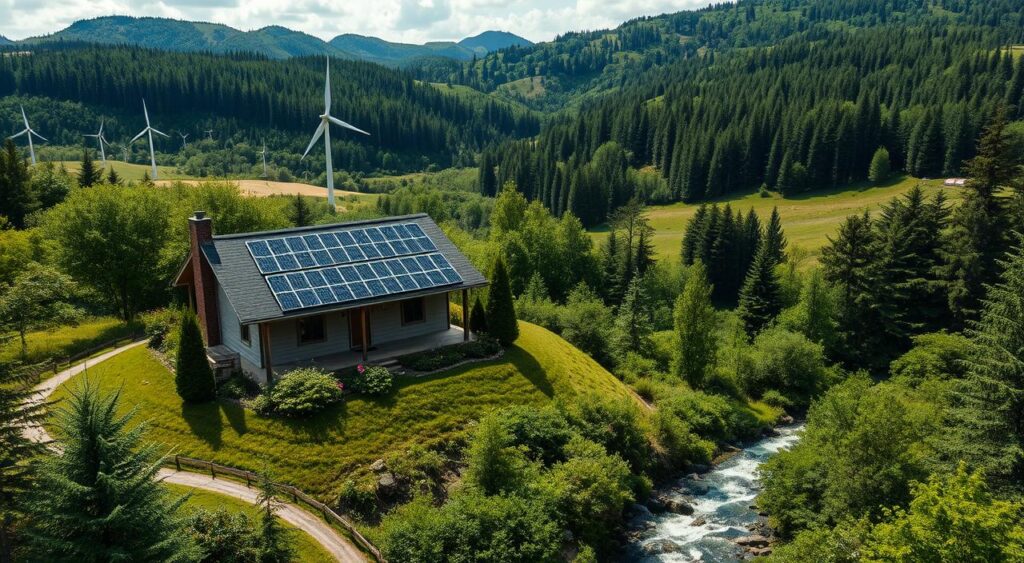
Builders are increasingly adopting sustainable practices, with about 90% now using sustainable materials in their projects. These choices can lead to higher returns on investment, making a green home a wise and responsible choice.
| Statistic | Value |
|---|---|
| Homebuyers preferring energy-efficient features | Over 70% |
| Reduction in energy costs from sustainable homes | 30% to 50% annually |
| Projected market for green building materials | $600 billion by 2025 |
| Premium for eco-friendly homes | 5-10% more than traditional homes |
| Builders using sustainable materials | 90% |
Key Principles of Green Building Practices
Green building is rooted in environmentally conscious construction. It focuses on energy efficiency, water conservation, waste reduction, and non-toxic materials. These sustainable design principles help create eco-friendly architecture that benefits both you and the planet.
Energy efficiency is a key component of sustainable living. Advanced insulation and energy-efficient appliances reduce energy use. Passive solar design enhances your home’s energy profile, using natural light to cut down on artificial lighting needs.
Water conservation is critical. Rainwater harvesting and drought-resistant landscaping save water and lower utility bills. Recycling construction materials and planning for minimal waste during renovations and new builds also help reduce waste.
Choosing non-toxic materials is essential for eco-friendly architecture. Opt for paints, adhesives, and flooring with low VOC emissions to improve indoor air quality. Sustainably sourced materials ensure your home is healthy and safe for everyone.
| Principle | Description | Benefits |
|---|---|---|
| Energy Efficiency | Utilizing energy-efficient design and technologies. | Reduces energy bills and carbon footprint. |
| Water Conservation | Implementing systems to reduce water waste. | Conserves precious resources and lowers costs. |
| Waste Reduction | Minimizing waste during construction and remodels. | Decreases landfill impact and promotes recycling. |
| Non-Toxic Materials | Choosing materials with low VOC emissions. | Improves indoor air quality and occupant health. |
Sustainable Home Design Techniques
Sustainable home design involves various techniques to boost energy efficiency and eco-friendliness. These strategies help cut down energy use and lessen environmental harm. Key areas to concentrate on include passive solar design and energy-efficient features.
Utilizing Passive Solar Design
Passive solar design uses the sun’s energy to control indoor temperatures. It involves orienting windows correctly and using thermal mass materials strategically. This approach minimizes the need for artificial heating, leading to energy savings. Homes benefit from this method, becoming more energy-efficient and lowering utility bills.
Incorporating Energy-Efficient Homes Features
Energy-efficient features are vital for sustainable homes. Investing in Energy Star appliances, high-performance windows, and efficient HVAC systems is essential. These upgrades can cut energy use by up to 50%. Adopting these features supports sustainable architecture and reduces your carbon footprint.
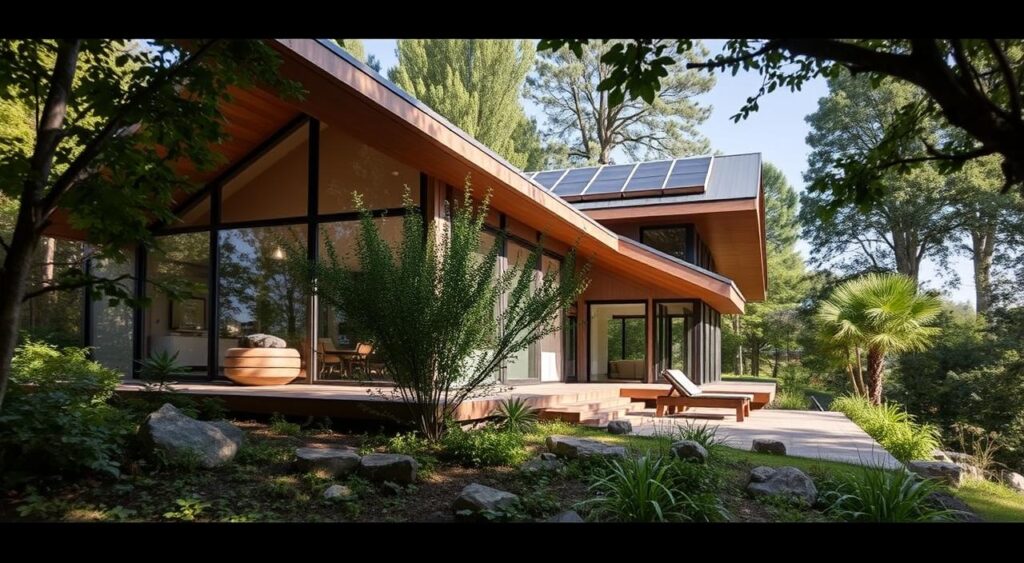
Sustainable Building Materials to Consider
Designing an eco-friendly home requires careful selection of sustainable building materials. These materials reduce environmental impact and enhance health. Focus on recycled materials, locally sourced products, and natural insulation for a solid foundation.
Recycled Materials
Recycled materials significantly cut down on waste, supporting a circular economy. Reclaimed wood, recycled metal, and repurposed brick are durable and aesthetically pleasing. They also reduce the environmental footprint of new production.
Locally Sourced Products
Opting for locally sourced materials reduces transportation emissions, a major contributor to climate change. These products use fewer resources for transport and boost local economies. They empower communities and foster sustainable practices.
Natural Insulation Options
Natural insulation, like cellulose, sheep’s wool, and cotton, excels in thermal management. These materials improve energy efficiency without the environmental drawbacks of synthetic insulations. They enhance home comfort while being eco-friendly.
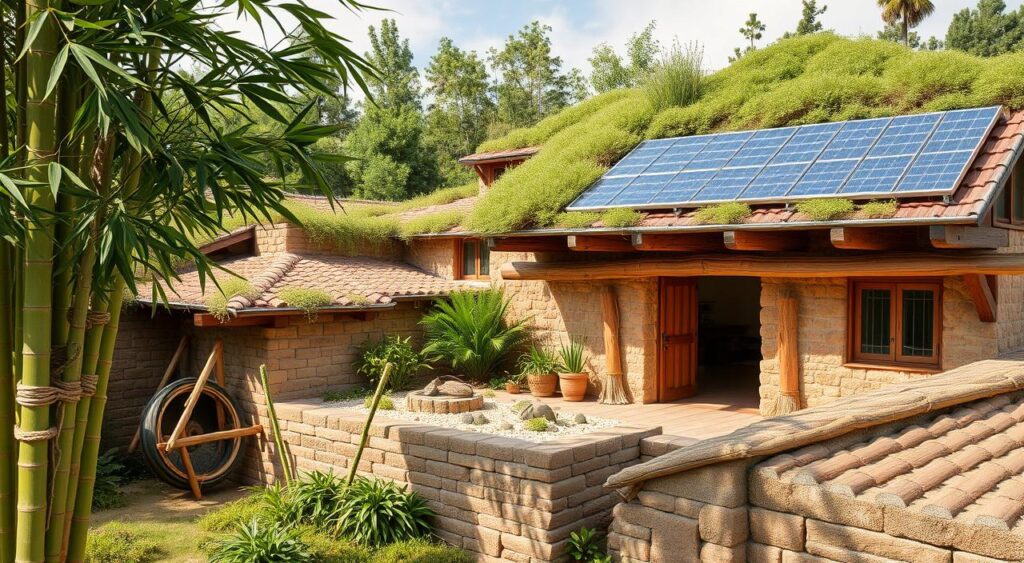
| Material Type | Benefits | Environmental Impact |
|---|---|---|
| Recycled Materials | Reduces waste and offers unique designs | Low, promotes circular economy |
| Locally Sourced Products | Supports local economies | Minimal transportation emissions |
| Natural Insulation | Effective thermal management | Low, less synthetic material usage |
Creating Energy-Efficient Systems in Your Home
To achieve a sustainable home, integrating energy-efficient systems is key. By adopting solar energy and smart home technology, homeowners can cut their carbon footprint. They also enjoy better comfort and lower utility bills.
Solar Energy Options
Solar energy is a powerful way to tap into the sun’s power for electricity. Homeowners can choose from solar panels and solar water heaters. This renewable energy reduces fossil fuel use and saves on energy costs. Options include:
- Photovoltaic Solar Panels: Convert sunlight into electricity.
- Solar Thermal Systems: Heat water using solar energy, providing hot water for home use.
- Solar Battery Storage: Stores excess energy for use when the sun isn’t out, boosting energy security.
Smart Home Technology for Energy Management
Smart home technology can transform energy management. It allows for real-time monitoring and automation, optimizing energy use. Features include:
- Smart Thermostats: Adjusts heating and cooling based on your schedule and preferences, reducing waste.
- Automated Lighting: Turns lights on and off based on occupancy, saving energy.
- Energy Monitoring Systems: Tracks energy use in real-time, helping to lower overall consumption.
Combining solar energy with smart home tech boosts energy efficiency. Investing in these systems makes your home more sustainable. It benefits your wallet and the environment.
| Technology | Benefit |
|---|---|
| Solar Panels | Generates clean electricity |
| Solar Water Heaters | Reduces water heating costs |
| Smart Thermostats | Improves climate control efficiency |
| Automated Lighting | Reduces energy waste |
| Energy Monitoring Systems | Offers consumption insights |
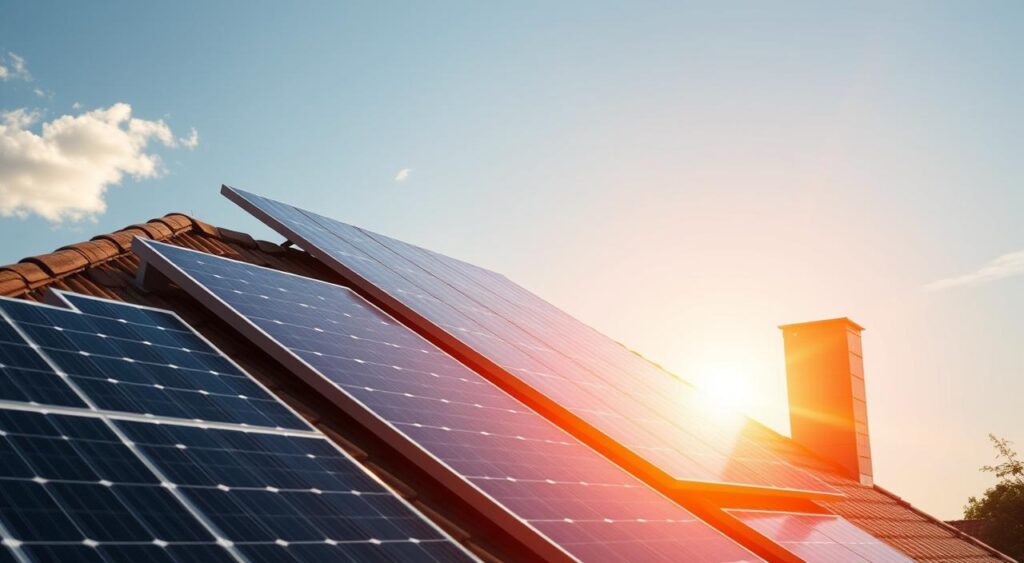
Integrating Sustainable Interior Design
Sustainable interior design focuses on creating spaces that are both beautiful and functional. It uses eco-friendly materials, improving aesthetics and promoting well-being. By choosing eco-friendly decor, you can enhance indoor air quality and lessen your ecological footprint.
Here are some key considerations for integrating sustainable interior design:
- Select furnishings made from sustainably sourced or recycled materials to minimize environmental impact.
- Choose non-toxic paint and finishes to ensure healthier indoor air quality.
- Utilize energy-efficient lighting solutions, such as LED bulbs, which consume less power and last longer.
- Incorporate natural textiles like organic cotton or hemp for upholstery and curtains.
Choosing eco-friendly decor boosts your home’s appeal while supporting sustainability. For example, furniture with a low environmental impact can result in stylish, responsible home designs.
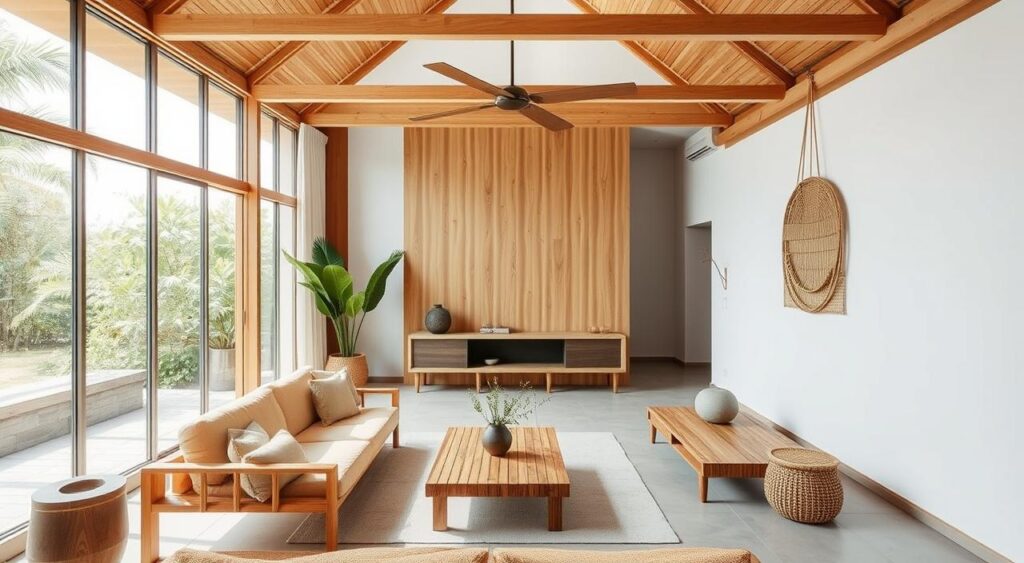
Eco-Friendly Landscaping Solutions
Transforming your outdoor space with eco-friendly landscaping solutions benefits both your environment and your home. By choosing native plants and water-efficient gardens, you create spaces that use fewer resources. This approach not only beautifies your home but also supports a healthier ecosystem.
Native Plants for Local Climate
Using native plants in your garden is a key eco-friendly landscaping practice. These plants thrive in local conditions, making them resilient and easy to care for. They need less water than non-native plants, which cuts down on irrigation needs. Here are some advantages of native plants:
- They attract local wildlife, including pollinators and beneficial insects.
- They improve soil health with deeper root systems.
- They lower maintenance costs by reducing the need for fertilizers and pesticides.
Water-Efficient Garden Design
Creating water-efficient gardens involves designing spaces that use less water while looking beautiful. Xeriscaping is a great method for this. It uses drought-resistant plants and strategic placement of elements. Consider these features for your water-efficient garden:
- Drip irrigation systems deliver water directly to plant roots.
- Mulching keeps soil moist and reduces evaporation.
- Rain gardens capture and filter rainwater runoff.

Adopting these eco-friendly landscaping solutions helps create a sustainable future. They enhance your outdoor space while supporting a natural ecosystem. Native plants and water-efficient garden design promote biodiversity and benefit the community.
| Feature | Benefits |
|---|---|
| Native Plants | Lower water requirements, attract local wildlife, reduced maintenance. |
| Xeriscaping | Efficient water use, aesthetic appeal, lower irrigation costs. |
| Rain Gardens | Improved water quality, reduction of runoff, habitat creation. |
Exploring Green Home Features
Adopting green home features can transform your living space into a sustainable haven. Innovations like green roofs offer insulation and boost biodiversity, adding both beauty and ecological value. Rainwater harvesting systems also play a key role, significantly cutting down on water usage and aiding in water conservation.
Energy-efficient windows are another critical element. They reduce heat loss, which in turn lowers energy bills for heating and cooling. This not only enhances your home’s efficiency but also helps in reducing your carbon footprint.
The interplay between interior and exterior landscaping is vital. Plants on green roofs or vertical gardens improve air quality and add natural beauty. Creating outdoor spaces that reflect your style and use native vegetation supports local ecosystems.
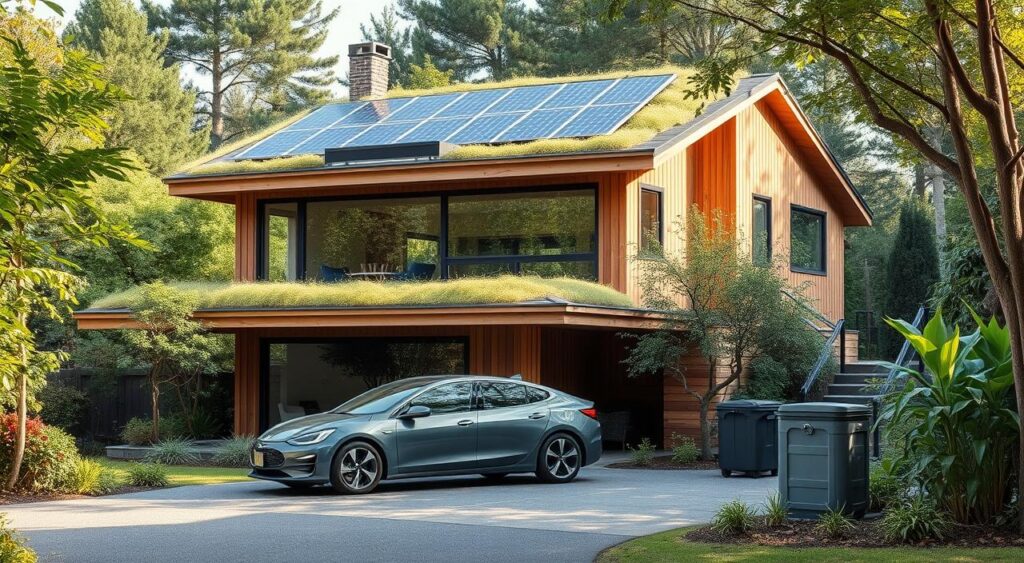
Here is a summary of some of the prominent green home features to consider:
| Green Home Feature | Description | Benefits |
|---|---|---|
| Green Roofs | Vegetation planted on rooftops. | Improves insulation, reduces heat island effect. |
| Rainwater Harvesting | Collecting rainwater for reuse. | Reduces water bills, conserves water resources. |
| Energy-Efficient Windows | Windows designed to minimize energy loss. | Lower energy costs, increased comfort. |
| Solar Panels | Photovoltaic systems converting sunlight to electricity. | Renewable energy source, reduced electricity bills. |
| Smart Home Technology | Devices that enhance energy efficiency. | Improves energy management and monitoring. |
By integrating these green home features, you can create a living space that benefits you and the environment. Embracing eco-friendly technologies in your renovation or construction efforts promotes sustainable living. It’s a practical and rewarding approach to living.
How to Decrease Your Home’s Carbon Footprint
To lower your home’s carbon footprint, adopt sustainable living and eco-friendly choices. Real estate is a significant contributor to global energy use, making up nearly 40%. By making smart decisions about your home’s design and operation, you can significantly reduce its ecological impact.
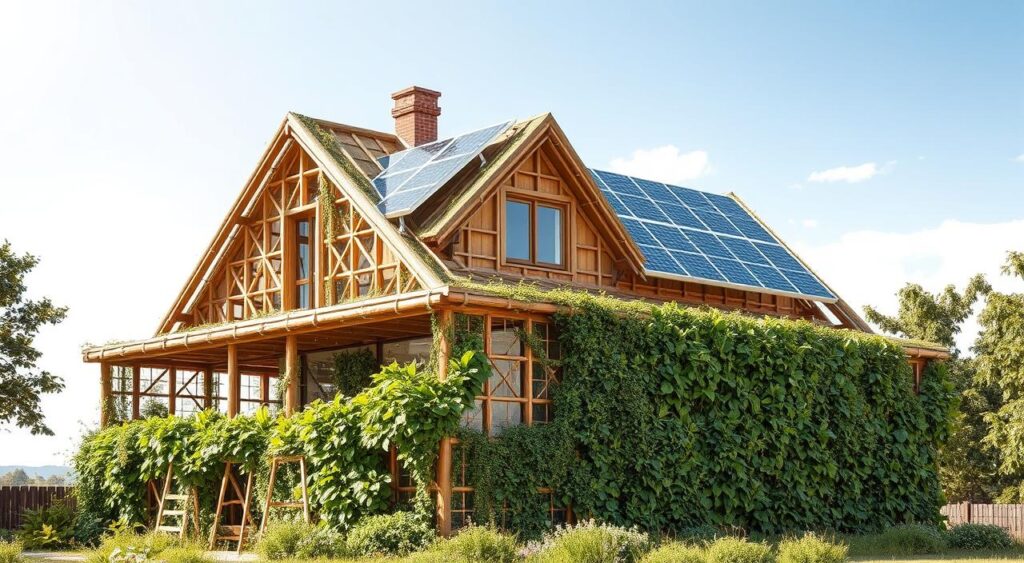
Energy-efficient technologies are key, reducing energy use in homes by up to 50%. Investing in these systems cuts emissions and boosts your property’s value. Green-certified buildings often command up to 10% more in rental yields due to lower costs, attracting both homeowners and investors.
Choosing sustainable materials like recycled steel and concrete can cut emissions by 20-30%. These choices highlight the impact of eco-friendly choices on your home’s carbon footprint.
- Enhance insulation for better energy efficiency.
- Use renewable energy sources like solar panels.
- Adopt water conservation with rainwater harvesting and greywater recycling, saving up to 40% of water.
Government incentives encourage carbon footprint reduction with tax breaks for green initiatives. This support makes sustainable living more accessible to everyone.
By integrating these strategies into your home, you contribute to reducing carbon footprints and promoting a healthier environment. Every step towards sustainability increases the collective impact, merging personal responsibility with community benefits.
Innovative Eco-Friendly Design Ideas
Adopting innovative design in housing can significantly alter sustainable architecture. You can explore various concepts that challenge traditional building methods, leading to eco-friendly solutions. Modular construction, for example, cuts down on waste and boosts efficiency in the building process.
Using shipping containers as homes is another creative strategy. This approach leverages recycled materials, fostering sustainability and presenting a distinctive aesthetic. Vertical gardens add layers of functionality and beauty, transforming exterior spaces. They also improve air quality and biodiversity.
A table below highlights several innovative eco-friendly design ideas along with their respective benefits:
| Design Idea | Benefits |
|---|---|
| Modular Construction | Minimizes waste and reduces construction time. |
| Shipping Container Homes | Utilizes recycled materials, cost-effective and customizable. |
| Vertical Gardens | Enhances aesthetics, improves air quality, and supports biodiversity. |
| Green Roofs | Insulates buildings, manages stormwater, and enhances urban biodiversity. |
| Passive Building Design | Reduces energy consumption through natural heating and cooling techniques. |
Incorporating these innovative eco-friendly solutions in your home design not only creates a visually stunning space. It also significantly contributes to a sustainable future. Prioritizing sustainable architecture helps achieve personal and community environmental stewardship goals.
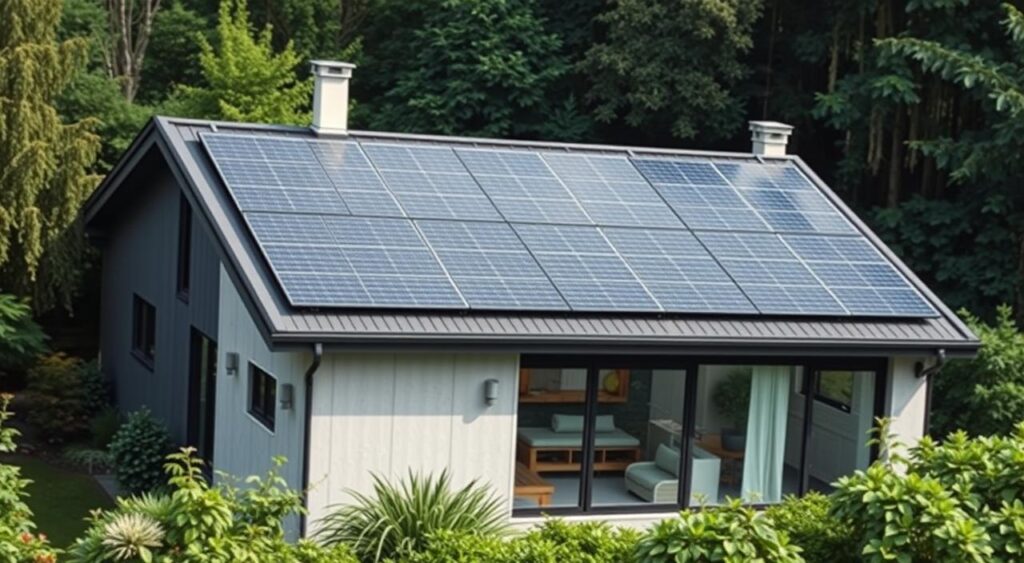
Sustainable Home Design: A Case Study
This section delves into a sustainable home case study, focusing on a straw bale residence in Ontario. It highlights how eco-friendly living is possible through innovative design and responsible resource use. The case study showcases the integration of natural materials and renewable energy, demonstrating best practices in sustainable home design.
The use of straw bales as insulation offers exceptional thermal performance, significantly reducing energy consumption. This passive design approach aligns with eco-friendly living principles, allowing homeowners to cut heating costs substantially. This case study illustrates the impressive efficiency of designs that prioritize environmental stewardship.
Features like rainwater harvesting and solar panel installation enhance the home’s sustainability. These elements not only contribute to energy savings but also reflect the growing trend of incorporating renewable energy into daily life. The benefits extend beyond the house, promoting awareness and support for sustainable community development.
Ultimately, this case study serves as an inspiration for those interested in eco-friendly living. By examining real-world examples of sustainable home design, you gain valuable insights into implementing your own green solutions.
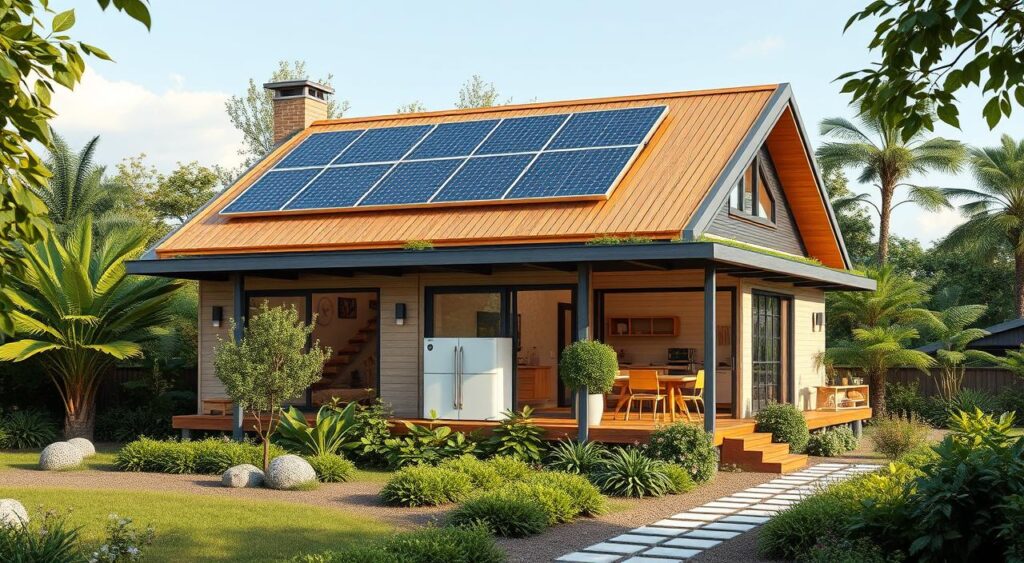
Common Misconceptions About Eco-Friendly Living
Many people believe that adopting sustainable practices is too costly. Yet, using energy-efficient appliances and simple conservation measures can lower utility bills. This leads to long-term savings, debunking the myth of high costs.
Another misconception is that eco-friendly living means sacrificing comfort and convenience. In reality, many sustainable options blend seamlessly into daily life. For instance, smart home technologies optimize energy use without disrupting daily routines.
Exploring the facts about green design can also dispel these myths. Studies reveal that eco-friendly buildings are better for the environment and human health. They offer natural lighting, improved air quality, and non-toxic materials, proving that sustainability doesn’t compromise comfort.

To clear up these misunderstandings, let’s compare common misconceptions with actual benefits:
| Misconception | Fact |
|---|---|
| Eco-friendly living is too expensive. | Initial costs can be offset by long-term savings on energy bills. |
| Sustainable designs lack comfort. | Many green designs focus on improving comfort and aesthetics. |
| Green products underperform. | Many eco-friendly products are now industry leaders in performance. |
| Living sustainably is inconvenient. | Many sustainable practices can be easily integrated into daily routines. |
By debunking these eco-friendly myths, you can adopt a lifestyle that benefits both you and the planet. Understanding sustainability empowers you to make choices that positively impact your life and the environment.
Challenges and Solutions in Sustainable Home Design
Sustainable home design encounters several hurdles that deter homeowners. The high upfront costs of eco-friendly materials and technologies are a major deterrent. Many homeowners lack the knowledge needed to navigate sustainable living options, feeling overwhelmed by the choices available.
Despite these obstacles, there are many sustainable solutions to make eco-friendly living more accessible. Workshops and community programs educate homeowners on sustainable practices, fostering awareness and motivation. Partnering with local businesses that offer eco-friendly materials can also reduce costs. These partnerships often lead to savings, making sustainable choices more affordable.
Government grants and incentives further encourage environmentally conscious decisions. By utilizing these resources, homeowners can alleviate financial burdens associated with green practices. Community support is essential in creating a culture that values sustainability, turning individual efforts into collective successes.
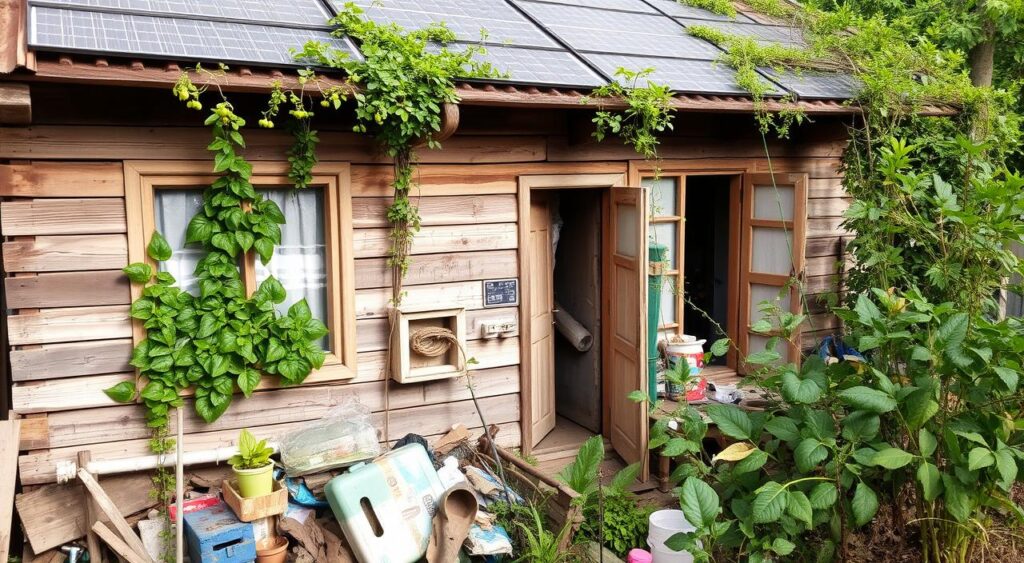
The table below highlights some common challenges and their sustainable solutions:
| Challenges | Sustainable Solutions |
|---|---|
| High Initial Costs | Government grants, local partnerships for discounts |
| Lack of Knowledge | Educational workshops and community programs |
| Variety of Options | Consulting with eco-design professionals |
| Resistance to Change | Community-driven sustainability initiatives and testimonials |
| Limited Access to Eco-Friendly Materials | Online resources and local eco-friendly suppliers |
Overcoming these challenges empowers individuals to embrace eco-friendly practices. It also strengthens community bonds, leading to a more sustainable future.
Community Impact of Sustainable Home Practices
Sustainable home practices significantly boost community benefits, promoting a culture of social responsibility and collective impact. By adopting eco-friendly methods, neighborhoods see better environmental quality. This leads to healthier living conditions for all residents.
🪄 Read also:
Improving food security through sustainable agriculture is another key benefit. This is vital for low-income areas, where it enhances nutrition and well-being. Grants for these methods can increase productivity by up to 60%, boosting local economies.
Community engagement in sustainable practices brings significant outcomes. For example, Detroit’s Urban Agriculture Initiative has turned over 30 vacant lots into urban farms. This initiative offers jobs and enriches local economies. It can create up to 15% more jobs, directly benefiting residents.
Sustainable practices also cut carbon footprints by about 30% compared to traditional farming. Grants empower smallholder farmers, leading to a 25% increase in crop yields. This can reduce poverty by up to 20% over five years.
Educational workshops on sustainable methods have increased knowledge sharing by over 50%. This strengthens community ties and promotes sustainability. It highlights the value of community-driven change.
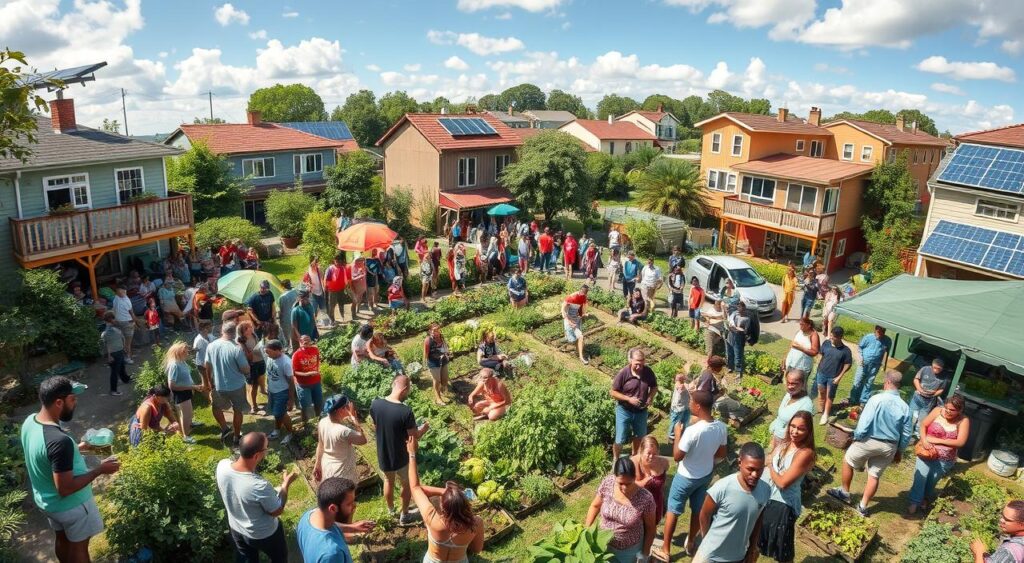
| Community Benefit | Impact |
|---|---|
| Improved Nutrition | Enhanced food security in low-income areas |
| Productivity Increase | Up to a 60% boost from sustainable agriculture grants |
| Job Opportunities | 15% job creation post-sustainable project implementation |
| Poverty Reduction | 20% reduction in poverty levels over five years |
| Knowledge Sharing | 50% increase from educational workshops |
| Carbon Footprint | 30% lower carbon emissions with sustainable practices |
Resources for Sustainable Living
Finding the right resources for eco-friendly living is key for those looking to live sustainably. Websites, organizations, and publications abound with insights and tools. These sustainable living guides empower you to make choices that benefit your environment and the world at large.
Here are some valuable resources to consider:
- Books: Titles on sustainable farming, eco-friendly habits, and energy efficiency offer deep knowledge.
- Websites: Visit sites like the Environmental Protection Agency (EPA) and local sustainability groups for the latest news and info.
- Local Community Groups: Joining local groups lets you connect with others who share your green interests.
The table below showcases notable programs and initiatives with real-world benefits:
| Program/Initiative | Location | Key Benefits |
|---|---|---|
| Agroecology for Food Security | Brazil | Increased crop yields by 30%, reduced chemical inputs |
| Urban Agriculture Initiative | Detroit | 20% job creation, 10% property value increase over five years |
| Grants for Sustainable Agriculture | Low-Income Areas | 40% improvement in food security, 50% reduction in food assistance reliance |
| Sustainable Farming Practices | Various States | 15% increase in profitability, 25% reduction in soil degradation |
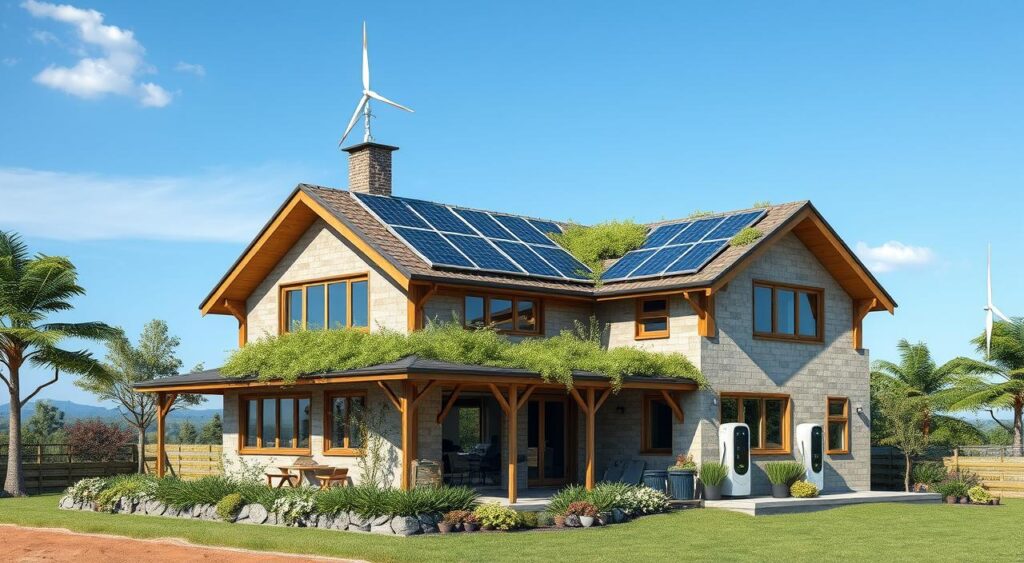
Conclusion
Embracing eco-friendly living through sustainable design practices greatly benefits both your home and the planet. By adopting green practices, you can see real improvements. These include energy savings and better air quality, which boost your health and well-being.
This summary emphasizes the role of eco-friendly materials and techniques in sustainable design. Using renewable energy and modern technology allows you to make choices that benefit your home, community, and future generations.
When you decide to add sustainable elements to your home, remember that every step counts. Choosing eco-friendly living is more than a trend. It’s a commitment to creating a sustainable and resilient home legacy.
FAQ
What is eco-friendly living?
Eco-friendly living means adopting habits that protect the environment. This includes reducing waste, conserving energy, and choosing sustainable materials for your home.
Why is sustainable home design important?
Sustainable home design is key to lowering your carbon footprint. It makes your home more energy-efficient, reduces waste, and uses materials responsibly. These efforts lead to lower utility bills and a healthier home environment.
What are the key principles of green building practices?
Green building focuses on energy efficiency, water conservation, waste reduction, and non-toxic materials. These principles guide every decision in sustainable home design.
How can I incorporate energy-efficient features into my home?
Improve your home’s efficiency by using passive solar design and natural sunlight. Choose Energy Star appliances and high-performance windows for better energy use.
What types of sustainable building materials should I consider?
Opt for recycled materials to cut down on waste. Choose locally sourced products to reduce transportation emissions. Natural insulation like cellulose is better than synthetic options for the environment.
What energy-efficient systems can I implement in my home?
Install solar energy systems for renewable power. Use smart home technology for better energy management. This can significantly lower your energy bills.
What does sustainable interior design involve?
Sustainable interior design uses eco-friendly materials and waste-reduction strategies. It focuses on creating beautiful spaces that also improve indoor air quality.
How can I create an eco-friendly landscape?
Use native plants in your garden to boost biodiversity and save water. Xeriscaping is another water-efficient option that adds beauty to your landscape.
What are green home features that I can consider?
Consider green roofs, rainwater harvesting systems, and energy-efficient windows. These features enhance your home’s look while promoting eco-friendly living.
How can I decrease my home’s carbon footprint?
Reduce energy use, choose sustainable materials, and manage waste effectively. Simple steps like better insulation and renewable energy can make a big difference.
What innovative eco-friendly design ideas are available?
Explore modular construction, using shipping containers as homes, and vertical gardens. These ideas challenge traditional building methods and support sustainability.
Are sustainable home design practices expensive?
Some sustainable practices may cost more upfront. Yet, they often lead to long-term savings on utility bills. Many eco-friendly options can be affordable with proper planning.
How do sustainable home practices impact communities?
Sustainable practices improve health, increase property values, and foster community bonds. They create a positive impact that benefits both local and broader communities.
Where can I find resources for sustainable living?
Resources include websites, books, and local organizations focused on eco-friendly practices. These support education and sustainable living.

AUTHOR: Madeline Turner
Expert in Home Design, Architecture, and Sustainable Living Trends
With over 25 years of experience in interior design and lifestyle writing, Madeline Turner brings a unique blend of creativity, research, and practical know-how to 17Vibes. Her expertise spans home renovations, smart home technology, eco-friendly materials, and modern décor trends. Follow me on LinkedIn
